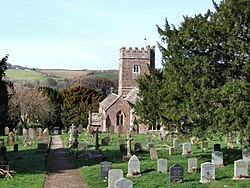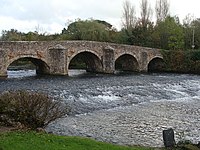Bickleigh, Exe: Difference between revisions
Created page with "{{hatnote|Not to be confused with Bickleigh in southern Devon}} {{Infobox town |name=Bickleigh |county=Devon |picture=The Church of St Mary the Virgin, Bic..." |
m clean up, replaced: medieval → mediæval (4) |
||
| Line 20: | Line 20: | ||
The 2001 census recorded a population of 239 in the parish. | The 2001 census recorded a population of 239 in the parish. | ||
The village lies in the valley of the River Exe, which river is spanned here by an attractive | The village lies in the valley of the River Exe, which river is spanned here by an attractive mediæval stone bridge. | ||
[[File:John White Abbott Bickleigh Court Devon.jpg|right|thumb|230px|Bickleigh Court before 1851, by John White Abbott]] | [[File:John White Abbott Bickleigh Court Devon.jpg|right|thumb|230px|Bickleigh Court before 1851, by John White Abbott]] | ||
| Line 28: | Line 28: | ||
==St Mary's Church== | ==St Mary's Church== | ||
Bickleigh's parish church, dedicated to St Mary The Virgin. It is a | Bickleigh's parish church, dedicated to St Mary The Virgin. It is a mediæval church predominantly built in the 14th century, though still contains a 12th-century south doorway and font. The subsequent restoration work of 1843 detracted from its original form.<ref name=hoskins>Hoskins, W. G. (1954) ''Devon''</ref> Its tower houses six bells. | ||
The church's history is closely bound with that of the Carew family, lords of the manor, and the church is noted for its Carew family monuments that date from the 16th and 17th century. The family's association continued until the manor's sale in 1922. | The church's history is closely bound with that of the Carew family, lords of the manor, and the church is noted for its Carew family monuments that date from the 16th and 17th century. The family's association continued until the manor's sale in 1922. | ||
| Line 34: | Line 34: | ||
The most notable member of the family was Bampfylde Moore Carew (1690–1758), the son of Theodore Carew, Bickleigh's rector. According to his own account, after a number of adventures, Carew became a gipsy and was subsequently elected their king. He was transported to Maryland but escaped back to Britain, and joined Bonnie Prince Charlie's army on its 1745 march to [[Derby]], before returning to Bickleigh until his death.<ref name=hoskins/> He is buried in the graveyard.<ref>Stabb, John (1908) ''Some Old Devon Churches'', (1908-16)</ref><ref name=dnb>{{cite DNB|wstitle=Carew, Bamfylde Moore|volume=9}}</ref> | The most notable member of the family was Bampfylde Moore Carew (1690–1758), the son of Theodore Carew, Bickleigh's rector. According to his own account, after a number of adventures, Carew became a gipsy and was subsequently elected their king. He was transported to Maryland but escaped back to Britain, and joined Bonnie Prince Charlie's army on its 1745 march to [[Derby]], before returning to Bickleigh until his death.<ref name=hoskins/> He is buried in the graveyard.<ref>Stabb, John (1908) ''Some Old Devon Churches'', (1908-16)</ref><ref name=dnb>{{cite DNB|wstitle=Carew, Bamfylde Moore|volume=9}}</ref> | ||
The church is home to carved bench-ends depicting scenes of | The church is home to carved bench-ends depicting scenes of mediæval life. Major John Gabriel Stedman, author of a ''History of Surinam'', d. 1797, was buried here in an unmarked grave near the vestry door.<ref name=dnb/> | ||
==About the village== | ==About the village== | ||
| Line 45: | Line 45: | ||
==Popular culture== | ==Popular culture== | ||
A persistent myth among the residents of the area is that the village's | A persistent myth among the residents of the area is that the village's mediæval bridge over the Exe inspired Paul Simon to write ''Bridge Over Troubled Water''; Simon is known to have stayed in the village in the mid-sixties. Although Art Garfunkel denied the rumour in a 2003 interview, stating that Simon had taken the phrase from a Baptist hymn,<ref>{{cite web|url=http://news.bbc.co.uk/1/hi/england/2736895.stm|title=Bridge rumour blown out of the water|publisher=BBC|date=February 7, 2003 | accessdate=January 1, 2010}}</ref> it is entirely possible that Simon intended more than one allusion. | ||
==Outside links== | ==Outside links== | ||
Latest revision as of 12:01, 30 January 2021
| Bickleigh | |
| Devon | |
|---|---|
 St Mary's Church, Bickleigh | |
| Location | |
| Grid reference: | SS939072 |
| Location: | 50°51’17"N, 3°30’28"W |
| Data | |
| Post town: | Tiverton |
| Postcode: | EX16 |
| Local Government | |
| Council: | Mid Devon |
Bickleigh is a village in the midst of Devon, on the River Exe about four miles south of Tiverton. It is within the Hayridge Hundred of the county.
The 2001 census recorded a population of 239 in the parish.
The village lies in the valley of the River Exe, which river is spanned here by an attractive mediæval stone bridge.

The village is mentioned in the Domesday Book as Bichelei, meaning "Bicca's meadow".[1]
Bickleigh Castle, the village manor house formerly known as Bickleigh Court, has a Norman chapel and font.
St Mary's Church
Bickleigh's parish church, dedicated to St Mary The Virgin. It is a mediæval church predominantly built in the 14th century, though still contains a 12th-century south doorway and font. The subsequent restoration work of 1843 detracted from its original form.[2] Its tower houses six bells.
The church's history is closely bound with that of the Carew family, lords of the manor, and the church is noted for its Carew family monuments that date from the 16th and 17th century. The family's association continued until the manor's sale in 1922.
The most notable member of the family was Bampfylde Moore Carew (1690–1758), the son of Theodore Carew, Bickleigh's rector. According to his own account, after a number of adventures, Carew became a gipsy and was subsequently elected their king. He was transported to Maryland but escaped back to Britain, and joined Bonnie Prince Charlie's army on its 1745 march to Derby, before returning to Bickleigh until his death.[2] He is buried in the graveyard.[3][4]
The church is home to carved bench-ends depicting scenes of mediæval life. Major John Gabriel Stedman, author of a History of Surinam, d. 1797, was buried here in an unmarked grave near the vestry door.[4]
About the village

Farmer Nick Lees and his family have constructed several maize mazes in a field near the village. The subjects include Queen Elizabeth II's Golden Jubilee, the 200th anniversary of the Battle of Trafalgar, the bicentenary of the birth of Isambard Kingdom Brunel and the 100th anniversary of the Scouting movement.[5]
This is also the location of one of the biggest vineyards in the West Country: Yearlstone, which has a state of the art winery, wine bar and cafe. Yearlstone is now eight and a half acres, and hosts Devon Wine Week in the last week in May each year, a celebration of local food culture.
To the northwest of the village on the River Exe is The Fisherman's Cot.
Popular culture
A persistent myth among the residents of the area is that the village's mediæval bridge over the Exe inspired Paul Simon to write Bridge Over Troubled Water; Simon is known to have stayed in the village in the mid-sixties. Although Art Garfunkel denied the rumour in a 2003 interview, stating that Simon had taken the phrase from a Baptist hymn,[6] it is entirely possible that Simon intended more than one allusion.
Outside links
| ("Wikimedia Commons" has material about Bickleigh, Exe) |
References
- ↑ James Johnson (1915). Place names of England and Wales.
- ↑ 2.0 2.1 Hoskins, W. G. (1954) Devon
- ↑ Stabb, John (1908) Some Old Devon Churches, (1908-16)
- ↑ 4.0 4.1 Dictionary of National Biography, Vol 9 : Carew, Bamfylde Moore
- ↑ "Maze celebrates scouts centenary". BBC. July 14, 2007. http://news.bbc.co.uk/1/hi/england/devon/6898775.stm. Retrieved January 1, 2010.
- ↑ "Bridge rumour blown out of the water". BBC. February 7, 2003. http://news.bbc.co.uk/1/hi/england/2736895.stm. Retrieved January 1, 2010.
